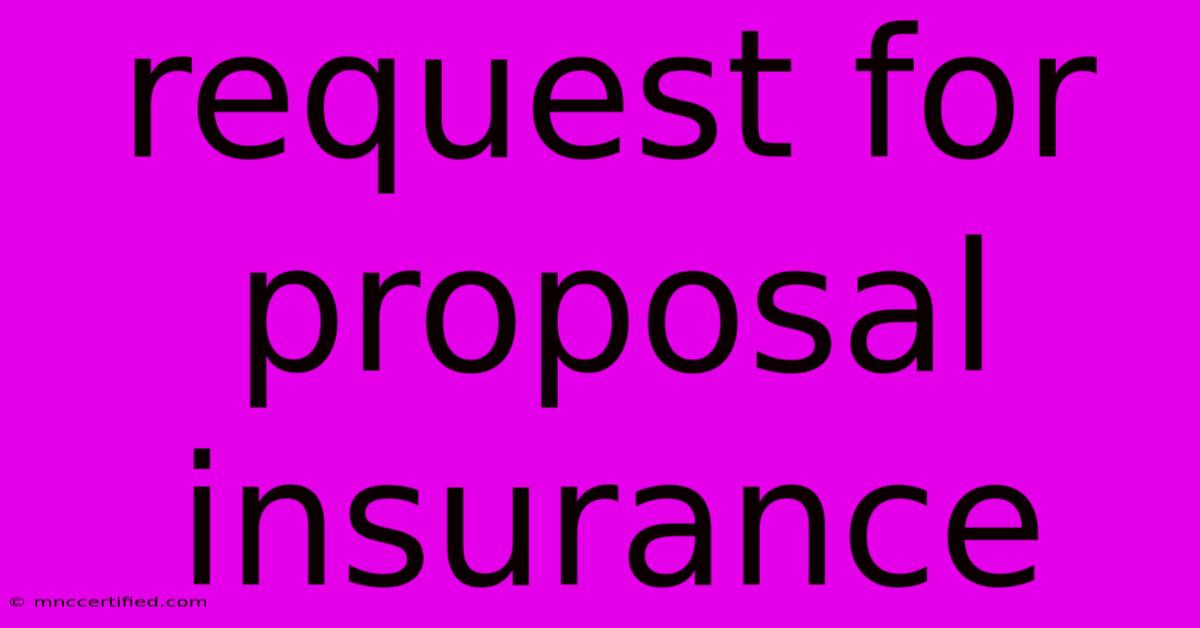Request For Proposal Insurance

Table of Contents
Request for Proposal (RFP) for Insurance: A Comprehensive Guide
Finding the right insurance coverage can feel overwhelming. A Request for Proposal (RFP) is a crucial tool to streamline the process, ensuring you receive competitive quotes and comprehensive coverage tailored to your specific needs. This guide will walk you through crafting a compelling RFP for insurance, maximizing your chances of securing the best possible policy.
Understanding the Importance of an Insurance RFP
An insurance RFP isn't just a formality; it's a strategic document that allows you to:
- Compare Apples to Apples: Receive standardized proposals from different insurers, making it easy to compare coverage, pricing, and service offerings.
- Clarify Your Needs: The process of writing the RFP forces you to articulate your exact insurance requirements, preventing misunderstandings down the line.
- Attract Qualified Bidders: A well-written RFP attracts reputable insurance providers who understand your needs and are capable of meeting them.
- Negotiate Favorable Terms: Having multiple proposals in hand gives you the leverage to negotiate better rates and more comprehensive coverage.
- Save Time and Resources: A structured RFP eliminates the need to contact numerous insurers individually, saving valuable time and resources.
Key Components of a Winning Insurance RFP
Your RFP should be clear, concise, and comprehensive. Here are the essential components:
1. Introduction and Overview
- Company Background: Briefly describe your organization, its history, and its operations. Include key financial information (if relevant).
- Purpose of the RFP: Clearly state your goal – to secure insurance coverage for [specific type of insurance, e.g., general liability, professional liability, property insurance].
- Timeline: Specify deadlines for proposal submission and anticipated contract commencement.
2. Detailed Insurance Requirements
This section is crucial. Be precise and specific:
- Coverage Requirements: Clearly define the types and amounts of coverage needed. Don't assume the insurer understands your industry's specific risks. For example, if you need cyber liability insurance, specify the coverage amount for data breaches and regulatory fines.
- Risk Assessment: Provide a thorough risk assessment of your organization. This could include details about your operations, potential hazards, past claims history, and any mitigation strategies in place. The more detail, the better the insurers can tailor proposals.
- Geographic Locations: Specify the locations covered by the insurance policy.
- Policy Period: Define the desired policy duration.
3. Proposal Submission Instructions
- Submission Deadline: State the firm deadline for proposal submissions.
- Format Requirements: Specify the required format for the proposal (e.g., PDF, Word document).
- Contact Information: Provide contact details for inquiries.
4. Evaluation Criteria
Outline how you will evaluate the proposals. This adds transparency and ensures fair comparison:
- Pricing: Weighting of premium cost versus coverage.
- Coverage Breadth: Extent of coverage offered.
- Claims Handling Process: Efficiency and responsiveness of the claims process.
- Financial Stability: Insurer's financial strength and rating.
- Service Quality: Responsiveness, communication, and overall customer service.
5. Contractual Terms and Conditions
Include general contractual requirements, such as:
- Policy Term: Length of the insurance policy.
- Renewal Options: Process for policy renewal.
- Cancellation Clause: Terms and conditions for policy cancellation.
- Dispute Resolution: Method for resolving disputes.
Optimizing Your Insurance RFP for Success
To maximize your chances of getting the best proposals, consider these optimization tips:
- Target Specific Insurers: Research and select insurers with a proven track record in your industry.
- Seek Professional Advice: Consult with an insurance broker who can guide you through the process and help you navigate complex insurance terminology.
- Review and Refine: Thoroughly review your RFP before distribution to ensure clarity and accuracy.
By following these guidelines and crafting a comprehensive and well-structured RFP for insurance, you can significantly improve your chances of securing the most appropriate and cost-effective coverage for your organization's needs. Remember that a well-prepared RFP is an investment in your organization's long-term security and financial stability.

Thank you for visiting our website wich cover about Request For Proposal Insurance. We hope the information provided has been useful to you. Feel free to contact us if you have any questions or need further assistance. See you next time and dont miss to bookmark.
Featured Posts
-
Standard Guaranty Insurance Co
Nov 27, 2024
-
Mack Browns Unc Exit After 2024
Nov 27, 2024
-
Cross Insurance Arena Capacity
Nov 27, 2024
-
How To Watch Barcelona Vs Brest Ucl
Nov 27, 2024
-
Live Stream Bayern Munich Vs Psg Odds
Nov 27, 2024